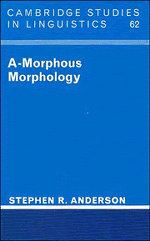Book contents
- Frontmatter
- Contents
- Acknowledgments
- Introduction
- 1 The study of word structure
- 2 Why have a morphology at all?
- 3 Is morphology really about morphemes?
- 4 The interaction of morphology and syntax
- 5 The theory of inflection
- 6 Some complex inflectional systems
- 7 Morphology in the lexicon: derivation
- 8 Clitics are phrasal affixes
- 9 The relation of morphology to phonology
- 10 How much structure do words have?
- 11 Composites: words with internal structure
- 12 Morphology and the typology of languages
- 13 Morphological change
- 14 Morphology as a computational problem
- References
- Index
4 - The interaction of morphology and syntax
Published online by Cambridge University Press: 10 January 2011
- Frontmatter
- Contents
- Acknowledgments
- Introduction
- 1 The study of word structure
- 2 Why have a morphology at all?
- 3 Is morphology really about morphemes?
- 4 The interaction of morphology and syntax
- 5 The theory of inflection
- 6 Some complex inflectional systems
- 7 Morphology in the lexicon: derivation
- 8 Clitics are phrasal affixes
- 9 The relation of morphology to phonology
- 10 How much structure do words have?
- 11 Composites: words with internal structure
- 12 Morphology and the typology of languages
- 13 Morphological change
- 14 Morphology as a computational problem
- References
- Index
Summary
We saw in the preceding chapters that it is at least worth investigating a theory of word structure based not on the classical notion of the morpheme, but rather on the premise that words are related to one another through the operation of processes called Word Formation Rules. It seems clear that the intuition of relatedness among words, captured on the traditional view by saying that they share a morpheme, can be reconstructed satisfactorily within this alternative approach by saying either that they share a base, that they share a morphologically relevant property such as [+ Plural], or that their derivations involve the same rule. Indeed, in separating these subtypes of ‘relatedness’ we arrive at a more nuanced view of the matter than one on which words simply do or do not share one or more entire morphemes. The question of how to reconstruct the internal relations of scope among the parts of a word, represented traditionally by an organization of its component morphemes into a constituent-structure tree, will be postponed until chapter 10, when more of the substance of a rule-based view has been developed. As pointed out at the end of chapter 3, there are a number of aspects of such a theory that need to be fleshed out.
- Type
- Chapter
- Information
- A-Morphous Morphology , pp. 73 - 101Publisher: Cambridge University PressPrint publication year: 1992



